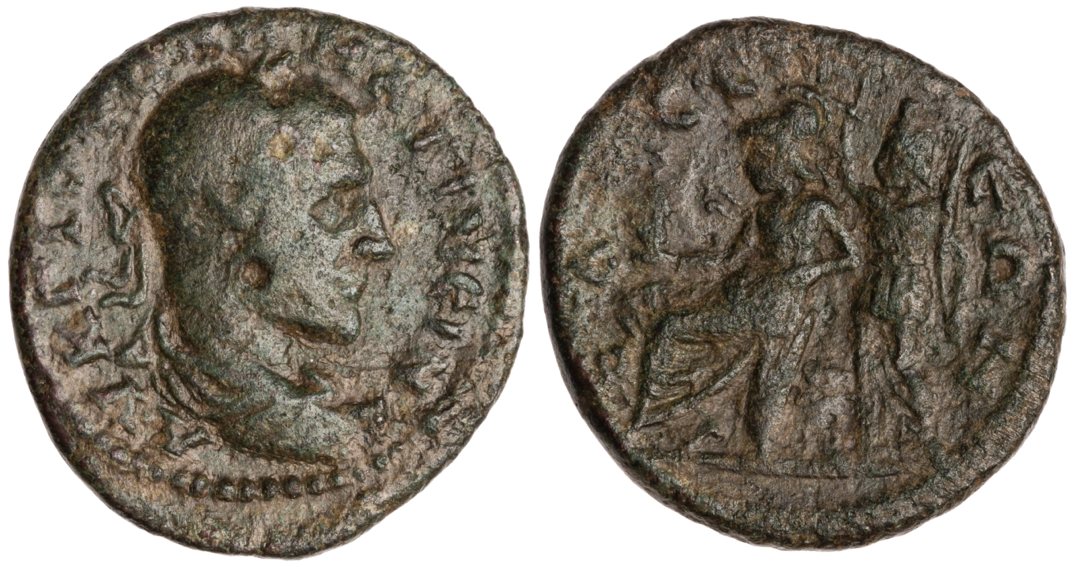RQEM ad. 25 - Edessa (Macedon) (Maximinus Thrax), bronze, dupondii (235-236 CE)
From SILVER
235 CE - 236 CE Bronze
Description
| ObverseInscription or printing placed on the obverse.: | Several legends: 1) Αὐτοκράτωρ Γ(άιος) Ἰού(λιος) Οὐῆ(ρος) Μαξιμεῖνος ; 2) Ἰούλ(ιος) Μάξιμος Καίσαρ (Greek).Several types: 1) Bust of Maximinus right, wearing laurel wreath, armour and drapery. Border of dots, 2) Bust of Maximus in three quarter, wearing laurel wreath and drapery. |
| ReverseInscription or printing placed on the reverse.: | ᾽Εδεσσέων (Greek).Personified Rome seated on shield and armour left, wearing Attic helmet and chiton, dagger in the belt, holding Nike stephanephoros in right hand. Behind her, personified Edessa, facing, wearing mural crown and peploss, holding spear and crowning Rome. Border of dots. |
Mint and issuing power
| MintIdentifies the place of manufacture or issue of a numismatic object.: | Edessa | Ancient regionAncient region.: | Macedon | Modern countryModern country: Greece | AuthorityIdentifies the issuing power. The authority can be "pretended" when the name or the portrait of X is on the coin but he/she was not the issuing power. It can also be "uncertain" when there is no mention of X on the coin but he/she was the issuing power according to the historical sources: | Maximinus Thrax (Roman emperor, 235-238 AD), Maximus (Roman emperor, 236-238 AD), Roman Empire |
Chronology
| FromIdentifies the initial date in a range assigned in a numismatic context. | 235 CE | toIdentifies the final date in a range assigned in a numismatic context.. | 236 CE | PeriodTime period of the numismatic object.: Roman from 30 BC |
Physical description
| MetalThe physical material (usually metal) from which an object is made.: | Bronze |
Median weightMedian of the weights of numismatic objects (in grams). in grams | 9.30 | DenominationTerm indicating the value of a numismatic object. Examples: tetradrachm, chalkous, denarius.: | dupondius |
StandardStandard.: |
Image

RQEM_ad_25.png "New York, ANS, 1951.64.2 (http" has not been listed as valid URI scheme.[New York, ANS, 1951.64.2 (http://numismatics.org/collection/1951.64.2)]
References
| Die study referencePublication of the study: | Papaefthymiou 20021Papaefthymiou 2002, p. 76, no. 1-3 and p. 77, no. 1-2. | ||
| Coin series referenceReference to coin series study: | |||
| Coin series web referenceCoin series web references: | |||
Obverse dies distribution
| FrequencyFrequency of specimen in distribution. ᵖ | Number of obversesNumber of obverse dies. ᵖ (o) | % (o) | Number of coinsNumber of coins. (n) | % (n) | Die nameName(s) of the die(s). |
| 3 | 1 | 50 | 3 | 37.5 | 1 (Gor.) |
| 5 | 1 | 50 | 5 | 62.5 | 1 (Max.) |
| Total | 2 of 2 | 100 | 8 of 8 | 100 |
Reverse dies distribution
no distribution is available
Quantification
| Number of obversesNumber of obverse dies. ᵖ (o) | 2 | Number of singletons (o1)The number of singleton coins. ᵖ | |
| Number of reverse diesNumber of reverse dies. (r) | 4 | Number of coinsNumber of coins. (n) | 8 |
| Coins per obverse dieNumber of coins per obverse die. (n/o) | 4 | Coins per reverse dieNumber of coins per reverse die. (n/r) | 2 |
| Reverse per obverse ratioRatio of obverse dies divided by reverse dies. (r/o) | 2 | Percentage of singletons (o1)number of coins (n) divided by the number of singletons (o1) ᵖ | % |
| Original number of dies (O) (Carter 1983 formula)The estimation of the number of coins according to Carter 1983 ᵖ | 2.33 | Coins struck if 20,000 as average productivity per dieCoins made if the average productivity for obverses (according to Carter) is 20,000. ᵖ | 46,600 |
| Original number of dies (O) (Esty 2011 formula)The estimation of the number of coins according to the singleton formula in Esty 2011 ᵖ (O) | 2.67 | Survival rate if 20,000 as average productivity per dieSurvival rate if average productivity is 20,000. ᵖ | 0.00017 |
| Coverage (o = % of O) (Esty 1984 formula)Esty 1984 - coverage (% of O) ᵖ (o = % of O) | % | Die productivity if survival rate 1/2,000Average productivity if survival rate is 1/2,000. ᵖ | 6,866.95 |
| Weight of silver (in kg) if 20,000 coins per die (O = Carter formula)Carter 1983 * Median weight * 20000 (*10 if gold or electrum) ᵖ | n.a. | Die productivity if survival rate 1/5,000Average productivity if survival rate is 1/5,000. ᵖ | 17,167.38 |
Remarks
The coinage of Maximinus is divided in 2 iconographic group : the coins with the portrait of Maximinus (dated from march 235 to june 236) and those with the portrait of Maximus (undated). Metrology p. 189-209.